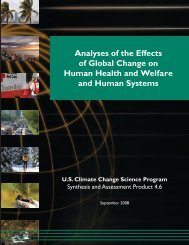Weather and Climate Extremes in a Changing Climate. Regions of ...
Weather and Climate Extremes in a Changing Climate. Regions of ...
Weather and Climate Extremes in a Changing Climate. Regions of ...
Create successful ePaper yourself
Turn your PDF publications into a flip-book with our unique Google optimized e-Paper software.
the exist<strong>in</strong>g uncerta<strong>in</strong>ties <strong>in</strong> tropical cyclone<br />
frequency <strong>and</strong> <strong>in</strong>tensity should cont<strong>in</strong>ue by the<br />
re-exam<strong>in</strong>ation <strong>of</strong> the heterogeneous records<br />
by a variety <strong>of</strong> experts to <strong>in</strong>sure that multiple<br />
perspectives on tropical cyclone frequency<br />
are <strong>in</strong>cluded <strong>in</strong> critical data sets <strong>and</strong> analyses.<br />
However, this notion <strong>of</strong> multiple <strong>in</strong>dependent<br />
experts <strong>and</strong> analyses should not be restricted<br />
to the question <strong>of</strong> tropical cyclone frequency,<br />
but should be applied to all aspects <strong>of</strong> climate<br />
research.<br />
4.3<br />
<strong>Weather</strong> observ<strong>in</strong>g systems adher<strong>in</strong>g<br />
to st<strong>and</strong>ards <strong>of</strong> observation<br />
consistent with the needs<br />
<strong>of</strong> both the climate <strong>and</strong> the<br />
weather research communities<br />
improve our ability to detect<br />
observed changes <strong>in</strong> climate<br />
extremes.<br />
Smaller-scale storms, such as thunderstorms<br />
<strong>and</strong> tornadoes are particularly difficult to observe<br />
s<strong>in</strong>ce historical observations have been<br />
highly dependent on population density. For<br />
example, the U.S. record <strong>of</strong> tornadoes shows<br />
a questionable upward trend that appears to be<br />
due ma<strong>in</strong>ly to <strong>in</strong>creases <strong>in</strong> population density<br />
<strong>in</strong> tornado-prone regions. With more people<br />
<strong>in</strong> these regions, tornadoes that may have<br />
gone unobserved <strong>in</strong> earlier parts <strong>of</strong> the record<br />
are now be<strong>in</strong>g recorded, thus hamper<strong>in</strong>g any<br />
analysis <strong>of</strong> true climate trends <strong>of</strong> these storms.<br />
S<strong>in</strong>ce many <strong>of</strong> the observations <strong>of</strong> extreme<br />
events are collected <strong>in</strong> support <strong>of</strong> operational<br />
weather forecast<strong>in</strong>g, changes <strong>in</strong> policies <strong>and</strong><br />
procedures regard<strong>in</strong>g those observations need<br />
to take climate change questions <strong>in</strong>to account<br />
<strong>in</strong> order to collect high-quality, consistently<br />
collected data over time <strong>and</strong> space. Therefore,<br />
consistent st<strong>and</strong>ards <strong>of</strong> collection <strong>of</strong> data about<br />
tornadoes <strong>and</strong> severe thunderstorms would be<br />
beneficial. Included <strong>in</strong> this process is a need for<br />
the collection <strong>of</strong> <strong>in</strong>formation about reports that<br />
allows users to know the confidence levels that<br />
can be applied to reports.<br />
However, <strong>in</strong> the absence <strong>of</strong> homogeneous observations<br />
<strong>of</strong> extremes, such as thunderstorms<br />
<strong>Weather</strong> <strong>and</strong> <strong>Climate</strong> <strong>Extremes</strong> <strong>in</strong> a Chang<strong>in</strong>g <strong>Climate</strong><br />
<strong>Regions</strong> <strong>of</strong> Focus: North America, Hawaii, Caribbean, <strong>and</strong> U.S. Pacific Isl<strong>and</strong>s<br />
<strong>and</strong> tornadoes, one<br />
promis<strong>in</strong>g method<br />
to <strong>in</strong>fer changes is<br />
through the use <strong>of</strong><br />
surrogate measures.<br />
For example, s<strong>in</strong>ce<br />
the data available to<br />
study past trends <strong>in</strong><br />
these k<strong>in</strong>ds <strong>of</strong> storms<br />
suffer from the problems<br />
outl<strong>in</strong>ed above,<br />
an <strong>in</strong>novative way to<br />
study past changes<br />
lies <strong>in</strong> techniques<br />
that relate environmental<br />
conditions to<br />
the occurrence <strong>of</strong> thunderstorms <strong>and</strong> tornadoes.<br />
Studies along these l<strong>in</strong>es could then produce<br />
better relationships than presently exist between<br />
favorable environments <strong>and</strong> storms.<br />
Those relationships could then be applied to<br />
past historical environmental observations <strong>and</strong><br />
reanalysis data to make improved estimates <strong>of</strong><br />
long-term trends.<br />
4.4<br />
Extended recontructions <strong>of</strong> past<br />
climate us<strong>in</strong>g weather models<br />
<strong>in</strong>itialized with homogenous<br />
surface observations would help<br />
improve our underst<strong>and</strong><strong>in</strong>g <strong>of</strong><br />
strong extratropical cyclones<br />
<strong>and</strong> other aspects <strong>of</strong> climate<br />
variability.<br />
Studies <strong>of</strong> the temporal variations <strong>in</strong> the frequency<br />
<strong>of</strong> strong extratropical cyclones have<br />
typically exam<strong>in</strong>ed the past 50 years <strong>and</strong> had to<br />
rely on reanalysis fields due to <strong>in</strong>consistencies<br />
with the historical record. But a much longer period<br />
would enable a better underst<strong>and</strong><strong>in</strong>g <strong>of</strong> possible<br />
multidecadal variability <strong>in</strong> strong storms.<br />
There are surface pressure observations extend<strong>in</strong>g<br />
back to the 19th century <strong>and</strong>, although the<br />
spatial density <strong>of</strong> stations decreases backwards<br />
<strong>in</strong> time, it may be possible to identify strong extratropical<br />
cyclones <strong>and</strong> make some deductions<br />
about long-term variations. Additionally, efforts<br />
to extend reanalysis products back to the early<br />
20th century us<strong>in</strong>g only surface observations<br />
119




